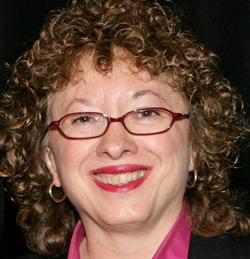Just as human beings have found safety in numbers, these colonies survive far better than free-swimming planktonic bacteria. Not only does the slime protect the bacteria from the environment and enemies that want to destroy it, but drug-resistant genes can easily be passed around.
Dr. Tessie McNeely, who holds a Ph.D. in experimental pathology from the University of North Carolina, has spent her career researching various pathogens, including studying plaque at the National Institute of Dental and Craniofacial Research.
From 1996 to 2013, she worked at Merck in research and development, testing vaccines for staphylococcus aureus, anthrax and, most recently, acne. When she learned about the prevalence of biofilms in chronic diseases, she became interested in finding a drug-free way to disrupt those colonies.
McNeely left Merck last year, and teamed up with Dr. Mark Schafer, a biomedical engineer specializing in ultrasound technology. Together they have developed the CLENS, a device that bombards biofilms with low-level ultrasound and blue light.
Starting on a shoestring in January of this year, they have already had success with this miniature shock-and-awe technique in vitro. If all goes well, they will start clinical trials this fall on patients with moderate-to-severe acne.
What inspired you to start PhotoSonix Medical?
One of the profoundly important aspects of biofilms is that we in the scientific and healthcare community don’t have any drugs that can kill a biofilm or eliminate it from the body. Bacteria in a biofilm are 500 to 1,000-fold more resistant to the effects of antibiotics than planktonic bacteria. So many chronic infections won’t resolve with antibiotics, probably due to the formation of a biofilm.
I thought this was a tremendous opportunity for Merck, and a really important unmet medical need, but I couldn’t get any traction there to work on biofilms.
After I left Merck, I happened to meet Mark Schafer at a fundraising event. It turned out that he had the same interest in biofilms. He told me he was an expert in ultrasound, and one of the many possible applications for ultrasound in the health field was biofilms. That caught my ear immediately.
A few weeks later, we discussed it further over lunch, and he told me that low-level ultrasound can cause a “micro-mechanical effect.” I was thinking this could actually work to disrupt a biofilm. It sounded like something the bacteria couldn’t evolve to evade, because there’s no ultrasound in nature.
We both came away from that lunch meeting very excited, and soon after we decided to work together… He had the expertise in ultrasound and I know something about bacteria and microbiology. Mark also had a friend, Adam Dakin, with whom he had worked in the past; he brought [Dakin] into our team because of his expertise in starting and raising capital for med-tech companies.
We started working together in January, and officially founded the company in April. In January we started writing grant proposals, because it takes about nine months for grants to come through.
What resources did you use in starting the company?
The founders have put in some of their own money as seed funding, and up to this point we’ve been running very lean. We have accomplished many major milestones on a very limited amount of capital.
Through a friend, we discovered that Montgomery County Community College has [a Center for Entrepreneurship Studies]. They have allowed us to do early development in a beautiful lab in their advanced technology building. It has all the equipment we could need, so we didn’t have to make this large initial investment. So we have space and a very supportive environment there. Access to MCCC’s resources has been instrumental in getting our company moving.
We have applied for a grant from the NIH, and were given a good priority score. Other funding sources we’ve applied to have given us positive feedback. We’re waiting to see if the funding comes through this fall.
We recently went to Houston because we were selected as one of two companies that would be evaluated for funding to develop a device that could be used by astronauts. We’ll find out soon if we won.
Once we get funding, we can move more quickly.
What have you done so far?
We’re developing a device that combines low-energy-level ultrasound with blue light. It is known that this light can interact specifically with molecules in bacteria, leading to toxic results in the bacteria. The combination of this with ultrasound, which causes a micro-mechanical stimulation of the bacteria, leads to death of bacteria and the breaking up of the biofilm.
We have been able to show this in vitro with a prototype device, which we used on staphylococcus epidermitis, a major cause of biofilms in the body.
While there are many potential applications for our technology, we obviously had to focus on an initial clinical indication. Based on my experience at Merck in the acne field, I knew that propionibacterium acnes, the bacteria that causes acne, could form a biofilm. That target became attractive because acne is a topical infection and there is an unmet medical need for moderate-to-severe acne treatment. We felt our CLENS (Coincident Light Energy and Nonfocused ultraSound) device would be effective.
We’re in the process of developing our data set to support the technology. We have already identified a site for human testing.
What is the device like?
It consists of a hand-held applicator, like a wand, and on the end of it is a round paddle that emits the combined energies. It’s held next to the skin, and connected to the power supply. It will probably be used for 15-minute treatments, possibly several times a week. The device will also require disposable covers, which we will market separately. Ultrasound requires gel, and that would be another disposable product we would sell. The price range will be comparable to current acne treatments. The device will be sold directly to physicians.
When will you be able to commercialize?
Compared to developing a drug, which can take decades, this should be relatively quick. We anticipate that it shouldn’t take more than a year to go through clearance with the FDA, and we should reach commercialization by early 2017.
What’s the big differentiator for your company?
This is a completely new way of attacking a biofilm. We have strong [intellectual property], including two issued patents and several pending.
One of the reasons we’re going after acne is that currently the only treatment that the American Dermatological Association has approved for the moderate-to-severe patient is Accutane. It works in most cases, but it has potentially severe side effects. Antibiotics used to work, but the bacteria have become resistant to them. Benzyl peroxide, available over the counter, is also losing some of its effectiveness on severe acne. We hope to be able to fill that gap.
What’s next for PhotoSonix Medical?
We have a number of applications we’re interested in. When we present our data and information to physicians, they invariably say, please try this on wounds, because biofilms are an important aspect of why some wounds don’t heal very well, particularly diabetic wounds.
Any foreign body implanted in the human body gets a biofilm on it. People often have to have an implant removed because there’s no way to get rid of the biofilm infection. We’ve been asked to look at catheter ports and dialysis fistula ports.
An area being researched by other people is rhinosinusitis. They are using blue light alone. We think if we use our CLENS device we’d have additional efficacy. That’s another really big market. But for now, we are focused on getting our CLENS acne system developed as quickly and efficiently as possible.
Writer: Susan L. Pena



